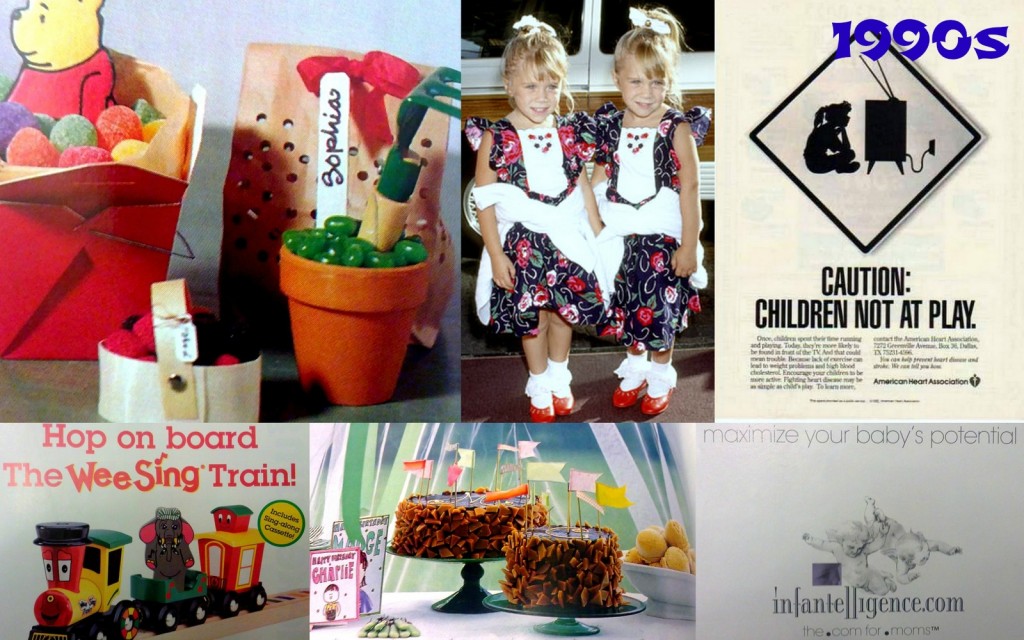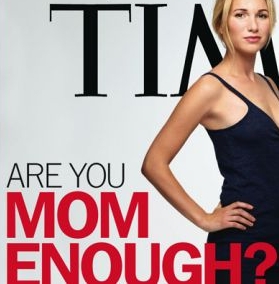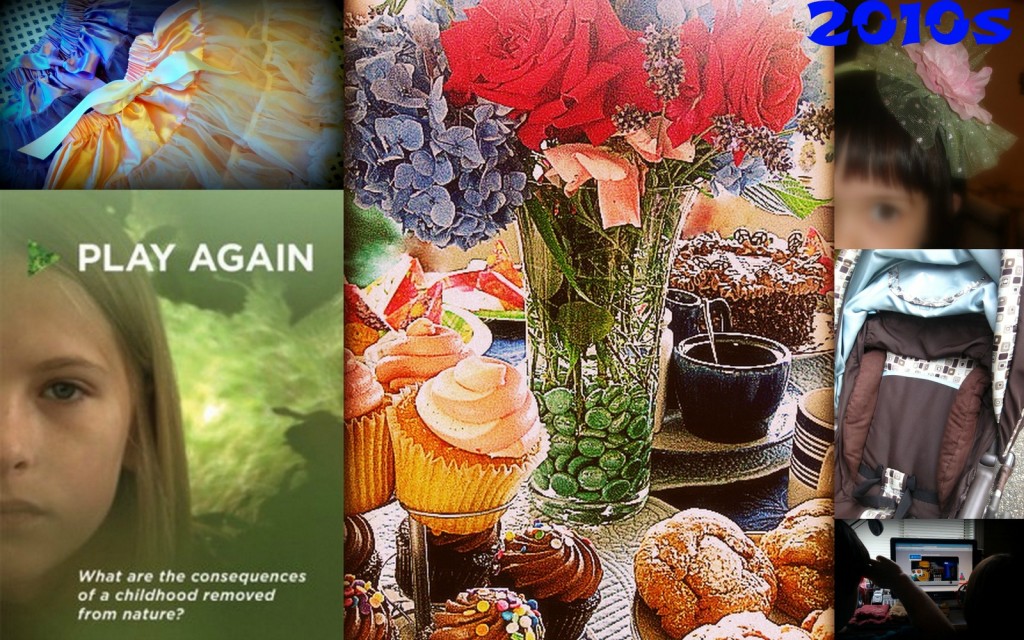 (Image source: top left and bottom middle – Martha Stewart Living magazine)
(Image source: top left and bottom middle – Martha Stewart Living magazine)
By Contributor Pamela Chan
Parents of today’s young adults were deeply immersed in parenting their young children fifteen to twenty years ago. Today’s parents hover like helicopters, parent like tigers and interact with their children like dolphins. Or at least that’s the impression news media stories give. Is parenting today really so different than how it was in the 90s?
Here are eight signs that the parenting style of Gen-X and Gen-Y parents is actually old school.
1. You Go Large Planning Children’s Parties
There was a time when Pin the Tail on the Donkey and a frosted birthday cake were enough to delight any child. Today, however, parties can have as many thrills per minutes as a Steven Spielberg production. Boa constrictors slither through kids? legs. Superheroes zap them with ray guns. Birthday cakes depict prehistoric scenes complete with dinosaurs and erupting volcanoes. (Martha Stewart Living Magazine, 1994)
You buy custom-made cupcakes and fill your children’s party table with Instagram-worthy food: special theme products and decorations; and, carefully thought out party favours. You spend days making some of these items and order the rest on Etsy. All this takes place at the ultimate party location. It just might be true that you live out your Pinterest fantasies when you plan your children’s social gatherings.
Old School: In the 1990s platters arrived at circle time and parties loaded with homemade cupcakes and sweets worthy of a Martha Stewart Living photo shoot. Goody bags overflowed with multiples of items ordered from party supply companies online.
2. You Are Raising Communication-Challenged Children
Once children spent most of their time running and playing. Today they’re more likely to spend most of their time in front of the television. (1992 ad)
You’ve read the reports and heard the veiled critiques from relatives. Youth are disconnected from others and don’t know how to communicate well face-to-face. They spend too much time tuned out while texting or using social media online.? Does this count as a parenting fail?
By age 3, almost one-third of children have a television in their bedroom. (American Academy of Pediatrics, 2012)
Old School: They didn’t have smart phones and texting back then (and the related problem of cyber bullying) but you could find youth spending long periods of time watching television shows and movies on videos, using computers, playing video games and listening to their portable CD players. Advice to parents about shutting off technology for youth even involved babies. The Baby Einstein company started back in the 1990s.
3. You Juggle Information Overload on a Daily Basis
By the 1990s, we come back to the strict regimented approach [prescribed] several decades earlier. More than 50 years on and experts still cannot agree on the best way to approach motherhood, and all this conflicting advice just leaves women feeling confused and disillusioned. (Angela Davis, University of Warwick)
You don’t miss an opportunity to read parenting articles online and, more rarely, in print. If there is a story going viral online about motherhood you’ve probably read and shared it. When you’re having a rough day you compare notes and find support using social media networks and parent websites.
Old School: Parents toted around the latest best selling parenting books and popular parenting magazines. Online access to articles and sharing links didn’t take off until the late 1990s and beyond. If you think funky parenting advice is a new trend, here’s an idea from a popular parenting book of the day. Did you know that if a young child sees his bodily waste flush down the toilet this can be very traumatic for him?
4. People Caution You About Your Parenting Ideas
Mommy Wars: the social conflict characterized by endless criticism, second-guessing, competition and sometimes outright meanness that seems to characterize parenthood, especially between mothers. (Source: Times Colonist, 2013)
Do you favour breastfeeding for a year and beyond; carrying your baby in a baby carrier for a good amount of time; natural childbirth; using paternal leave; co-sleeping; delaying solids; and, following your babies cues? Most mothers in British Columbia try many of these ideas. Still they are not universally popular. The roots of the so-called Mommy Wars can be found in conversations about these choices.
Old School: These parenting ideas were popular to varying degrees twenty years ago. They were considered to be a new, natural approach compared to pregnancy and parenting practices that had been popular for a few decades. Breastfeeding, for example, was not encouraged in the 1960s and earlier.
5. You Bought Too Much For Your Baby
In one UK study it was reported that the average parent spends approximately $9,000 in the first year of a baby’s life. (Guardian article)
A swank stroller, deluxe diaper bags, ergonomically correct baby carriers, play mat with a mobile, portable playpen (used as beds) and deluxe crib were all on your baby gift registry. Mothers in your play group discussed where they could buy soothers made out of organically produced rubber from South America.
Old School: The latest style of strollers, playmats with mobiles, playpens, diaper bags, baby carriers and overstuffed cribs were popular. Crack open those photo albums. All the baby paraphernalia was there.
6. You Over Dress Your Children
Your children wear all the popular labels plus clothes made by Etsy artisans and small-scale clothing designers. Your daughter is a vision of pink and sparkles. Think tutus with one of a kind headbands and hair clips. Hands up if your daughter wears her tutu to preschool?
Old School: Children wore dresses with lace, flounces, velvet, ribbons and matching headpieces, and bow ties. Princess themes, Disney and pink themes were popular. More affluent children wore Tintin products and clothes from exclusive west side children’s clothing boutiques.
7. You Buy Too Many Toys For Your Children
In the late 1990s the advertising firm Saatchi and Saatchi hired cultural anthropologists to study children engaging with digital technology at home in order to figure out how best to engage them with brands and products. (How Marketers Target Kids, 2008)
In these post recession years we don’t hear much about excessive consumer spending on the one hand. Meanwhile marketing experts report that other factors are influencing spending on children.
Parents today are willing to buy more for their kids because trends such as smaller family size, dual incomes and postponing having children until later in life mean that families have more disposable income. As well, guilt can play a role in spending decisions as time-stressed parents substitute material goods for time spent with their kids. (How Marketers Target Kids, 2008)
Even though the peak of the recent recession is still in sight, and many families are living in cash strapped homes in BC, this hasn’t put a stop to comments about children having too many toys. Nobody seems to notice that they’re mostly hand me downs, red ticket items from Winners and presents from grandparents. Nobody buys children’s items new these days?, one Craigslist seller said recently as she sold a like-new children’s bike.
Old School: From My Little Pony and Polly Pocket to Barney the Dinosaur products, Beanie babies and piles of McDonald’s Toys, playrooms were hardly minimalistic in the 1990s. Go back to those old photo albums and spot the piles of toys in the corners in the photographs. Forget the fuzzy memories of Boomer parents. The evidence is in the home video.
8. Your Parenting Efforts Are Under the Microscope
 Motherhood, in particular, is under the microscope. Is it a slow month in the newsroom? Why not circulate a piece about mothers? Articles in newspapers and magazines are re-shared widely as prominent business women reflect on their role as mother and career women. How is it all fitting together?
Motherhood, in particular, is under the microscope. Is it a slow month in the newsroom? Why not circulate a piece about mothers? Articles in newspapers and magazines are re-shared widely as prominent business women reflect on their role as mother and career women. How is it all fitting together?
Old School: Journalists wrote about the juggler (in Redbook) or “superwoman” and discussed work and home life concerns in a post 70s and 80s context. It hadn’t been that long since the double income household had become the norm for families. Other than letters to the editors and private conversations, you couldn’t weigh in on the information that was shared.
The issue of how much adults, -especially parents- work was a hot one in the 1990s. […] The image of “overworked” mothers and fathers caught the attention of journalists and researchers alike in the 1990s. (Work and Family in the 90s)
Potentially “trending” stories sell advertising and some people love to be armchair critics. Should these voices dominate the dialogue about today’s parenting efforts? Every time we click on an article that supports “news light” topics about parenting or Mommy War material, we encourage this focus. Access to affordable and high quality daycare and early childhood education was an issue in the 1990s and remains a major concern. The child poverty rate – already a problem in the 1990s – is even more of a concern now. Meanwhile the advent of cyber bullying has taken concerns regarding youth and mental health to a new crisis level. We can use our “click throughs” and private conversations and online sharing power to emphasize parenting stories that really matter.
Related
- The child poverty rate is even higher now than it was twenty years ago. Children are still showing up at school late and/or hungry.
- A recap of the ’90s. (The Mommy Wars. Ms. Magazine, February, 2000)
- Parents have a sense of humour and can laugh at themselves. Still – why would you share an article that encourages nit picking about parenting and who is the woman holding the twins next to a child? Is she a real-life mom we shouldn’t like? Does she know that her photo is on this blog post? 10 Parents we All Recognize and Might Want to Avoid
Pamela Chan lives in the Tri Cities area near Vancouver with her husband and four year old twins. They enjoy exploring cultural events and scenic local parks. On BCfamily.ca she writes about ideas that strengthen our communities and celebrate multiculturalism in British Columbia.










19 Comments on “8 Signs Your Parenting Style is Old School”
Great post! I agree, so many posts featuring the “mommy wars”, just not enough emphasis on the positive stories.
It really does feel like motherhood is under the microscope, with perfect “Pinterets” parents everywhere comparing what you did or didn’t and how much more they must care about their children.
Cyber-bullying is also a big issue nowadays. I keep hearing about young kids committing suicide from being bullied online.
You had me with the birthday parties. It is one of my pet peeves for some reason. I just cannot see how anyone can justify spending hundreds perhaps thousands of dollars on a birthday party that in many cases a child is too young to even remember. I think parenting “fads” change, but let’s hope that the fundamentals will remain the same.
I am with you Robin,its all about money these days.
Great post! No matter what your parenting style there is always someone that has an issue with it. If I could afford to throw lavish birthday parties, I would. I live in the range I can afford & it doesn’t take me months of saving to make a fun party happen.
Parenting styles will change and morph, some will stay the same. Some things like the technology race just plain scares me of what is going to happen yet in raising children. We all do our best and that is what is important.
I definitely fall under some of these
A mum of two young girls (both still in Elementary school) mentioned recently on Facebook that she asked her girls about the large parties she’d thrown for them previously. It must have been when they were older toddlers/preschool age. She basically said that they don’t really remember them and that should be a lesson to other mums to not worry too much about the details. Just have fun. I really wanted to do an Alice in Wonderland theme for my 4 year olds this past summer. I’ve never done the splashy party like I had when I was young (toned down 70s style) or what you see on Pinterest (custom banners et al.). So I thought “this year I’m going to do it”. I didn’t. I had flowers from the garden (hooray for the hydrangea bush previous tenants planted) and desserts on the table but that was it. I guess the comment I read did influence me and I had to accept that it costs a lot to buy the supplies to make all of those things and I had just enough time to do what I did. ..which was enough.
I think Communication-Challenged Children is a biggie! There was a story in the paper about how many kids are struggling with cursive writing because they simply don’t write anymore. Scary!
So true. Parenting choices are too criticized. I totally agree with the communication challenged problem and the strange attitude towards breastfeeding.
Ha this is totally me. My parties have to have lots of food and people and swimming and a character coming to entertain the kids. My house has lots of toys, and I am trying to pare down now and donate and clear out baby stuff.
Thanks so much for making me laugh.
Really great post. I can see some of these in our parenting style, and some that we work against. Its all about balance.
No.1: You go large planning children’s Parties. I must go back to Rip VanWinkle. My m other allowed me one friend, my favorite supper and a birthday cake.
I enlarged on that somewhat with a party of close friends, pizza and cake with ice cream. Does that make me a dinosaur?! (I must admit that in later years, I had personalized ‘Dairy Queen Cakes made for my husband.)
No 2–You Are Raising Communication-Challenged Children… — Effective parents will not, in my opinion, allow children to sit before any technological invention, for hours at a time. They will insist on ‘chores’, (age appropriate); homework; playing outside when the weather allows and promote interaction with friends.
Raising ;children with a sense of their own self-worth, a ‘can-do’ attitude and kindness to others are two of the most important assets you can inspire in them in my opinion
Children who are encouraged to try for their dreams should not have too much difficulty in relating to the new changes brought in by technology.
No.1 You Juggle Information Overload on a Daily Basis…
I agree that the new Mothers I know seem to feel that they have all the information at their fingertips and can get it easily-that is usually before the baby is born.
They are warned not to let a baby sleep on its back.
I know a mother whose child refused to sleep any other way. After exhaustion took over, she admitted defeat and bought a buzzer for the crib which was supposed to go off if the baby ceased to breathe.
Even her Doctor gave her repeated warnings about this practise until, one day, the baby, in its little bassine,t lifted up his head and shoulders and took a good long look at her. She also acknowledged defeat by her attitude after that.
No matter if you are old or new school,, Baby usually has the final say in many matters.(Which no book will admit except maybe Dr. Spock.)
No.4–People Caution You About Your Parenting Ideas…
I would caution anyone who allows his/her baby to sleep in the parent’s bed. I am sure it is an invitation for tragedy as the baby may be smothered.
I agree with you about breastfeeding. I was in a hospital ward with 24 other mothers. A Mother, who had come here from Holland, and I were the only ones breastfeeding our babies. She was in my ward and gave me valuable tips about methods and moisturizers for my breast, etc. I appreciated her advice very much. Two of my three daughters chose to breas-t feed and one of my daughters-in-law. My granddaughters (three) breast fed but one had to stop because of severe allergy of her baby to the milk protein in her milk. He had to go on special milk, then soy and still is on soy at three years of age.He can have some cheese, yougart and icecream so can enjoy the good things of life.
This really is a great post !
!No matter what your parenting style is someone will find a flaw in it.
I think some parents try to live thru their children and have all the things they wanted………its not about you MOM its a bout the kids